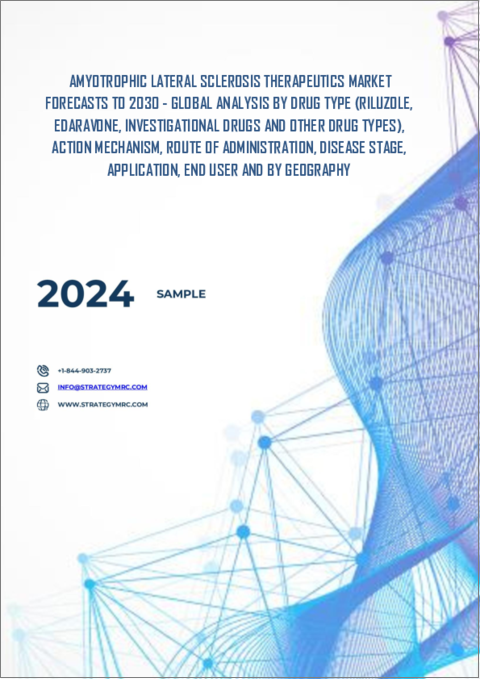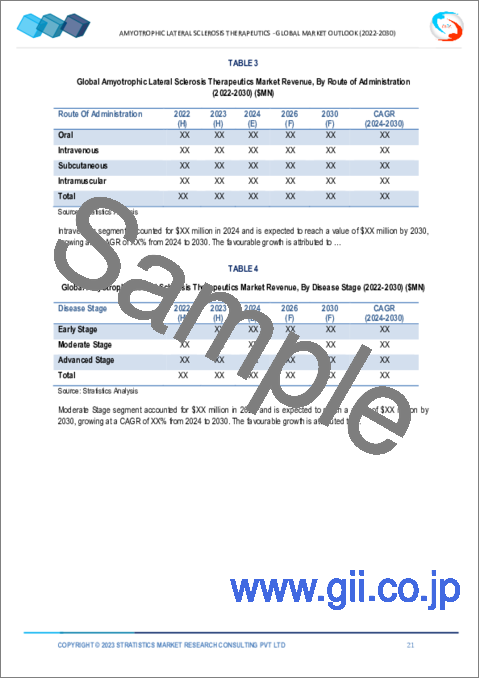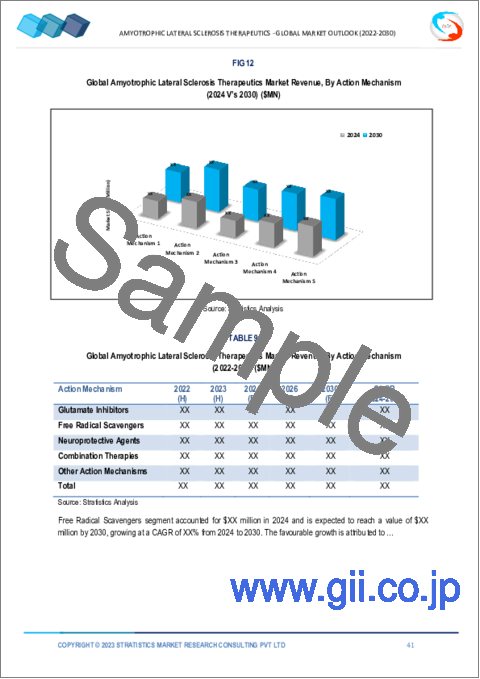|
|
市場調査レポート
商品コード
1577094
筋萎縮性側索硬化症(ALS)治療薬市場の2030年までの予測: 薬剤タイプ、作用機序、投与経路、病期、用途、エンドユーザー、地域別の世界分析Amyotrophic Lateral Sclerosis Therapeutics Market Forecasts to 2030 - Global Analysis By Drug Type, Action Mechanism, Route Of Administration, Disease Stage, Application, End User and By Geography |
||||||
カスタマイズ可能
|
|||||||
| 筋萎縮性側索硬化症(ALS)治療薬市場の2030年までの予測: 薬剤タイプ、作用機序、投与経路、病期、用途、エンドユーザー、地域別の世界分析 |
|
出版日: 2024年10月10日
発行: Stratistics Market Research Consulting
ページ情報: 英文 200+ Pages
納期: 2~3営業日
|
全表示
- 概要
- 図表
- 目次
Stratistics MRCによると、筋萎縮性側索硬化症(ALS)治療薬の世界市場は2024年に8億6,000万米ドルを占め、2030年には23億1,000万米ドルに達すると予測され、予測期間中のCAGRは12.6%です。
筋萎縮性側索硬化症(ALS)治療薬は、脳や脊髄の運動ニューロンを侵す神経変性疾患であるALS患者の症状管理、疾患進行の抑制、QOLの改善を目的とした様々な治療を包含します。治療薬は、筋力低下、痙縮、疼痛などの症状を緩和し、患者の快適さと生活の質を向上させる。
米国疾病管理予防センター(CDC)のMorbidity and Mortality Weekly Reportに掲載されたデータによると、2015年には米国で約16,583例の筋萎縮性側索硬化症の患者が確認されました。
増加する罹患率
ALSと診断される患者が増えるにつれて、効果的な治療法の需要が高まり、研究開発投資が促進されます。製薬企業は技術革新に意欲を燃やし、新しい治療法や臨床試験の導入につながります。さらに、ALSに対する認識と支持の高まりは、研究イニシアティブへの資金提供や支援の増加につながります。このような患者数の増加と疾患理解の進歩が相まって、標的を絞った個別化治療法の開発が促進され、成長の原動力となっています。
複雑な制御経路
筋萎縮性側索硬化症(ALS)治療薬の複雑な規制経路は、この疾患の希少性と多面性に起因します。多くの場合、多様な患者集団を含む大規模な臨床試験が必要であるため、医薬品の承認が遅れることがあります。有効性と安全性を実証するための厳しい要件が、さらにプロセスを複雑にしています。その結果、新規治療薬の市場投入が遅れることで、患者の治療選択肢が制限され、市場全体の成長が阻害されることになります。
集学的治療と支持療法の重視の高まり
ALS治療のアプローチは、神経学、呼吸療法、栄養学、緩和ケアを統合し、患者のQOLと治療成績を向上させる。共同ケアモデルは包括的な治療計画の策定を促進し、革新的な治療薬や支持的介入に対する需要を牽引しています。さらに、ALSに対する認識の高まりと個別化ケアの必要性が、研究投資とパートナーシップを促進し、新規治療法の出現につながっています。このような総合的なアプローチは患者のアドヒアランスと満足度を高め、市場の成長をさらに後押ししています。
高い治療費
ALS治療における高額な治療費は、疾患の複雑さ、高度な薬剤の必要性、継続的な支持療法に起因します。革新的な治療は供給が限られていることが多く、多額の研究開発投資が必要となるため、価格が高騰します。こうした高コストは、患者のアクセスを制限し、経済的負担を生じさせ、治療レジメンのアドヒアランスを低下させる。その結果、患者数が制限され、ALS治療薬に対する全体的な需要が減少するため、新製品開発や市場開拓の可能性に影響を与え、市場成長の妨げとなります。
COVID-19の影響
COVID-19の大流行は、臨床試験や研究活動を混乱させ、新しい治療法の開発や承認を遅らせることにより、ALS治療薬市場に大きな影響を与えました。患者はヘルスケアサービスへのアクセスで課題に直面し、治療レジメンの中断や患者のモニタリングの低下につながった。さらに、COVID-19に焦点が当てられたことで、ALS研究から資源と資金が流出しました。しかし、パンデミックによって遠隔医療が普及し、患者のサポートや相談が継続的に行われるようになったため、ALS患者の長期的なケア戦略に役立つ可能性があります。
予測期間中はリルゾールセグメンテーションが最大となる見込み
リルゾール分野は予測期間を通じて最大の市場シェアを確保すると予測されています。リルゾールは、筋萎縮性側索硬化症(ALS)の治療に使用されるFDA承認薬です。グルタミン酸拮抗薬に分類され、過剰に存在すると神経細胞の損傷を引き起こす神経伝達物質であるグルタミン酸の放出を阻害することで効果を発揮します。リルゾールはALS患者の病気の進行を遅らせ、生存期間を延長することが示されており、重要な治療選択肢となっています。
予測期間中、実験的療法分野のCAGRが最も高くなる見込み
実験的治療分野は予測期間中に最も高いCAGRを示すと予測されています。ALSの実験的治療法は、この疾患の根本的なメカニズムを標的とすることで、有望な効果をもたらします。個別化医療に焦点を当てることで、これらの実験的治療は患者の転帰とQOLの向上を目指しています。さらに、ALSに対するより深い理解に貢献し、将来のブレークスルーへの道を開くとともに、ALS患者に対する治療法の展望を広げています。
最大のシェアを占める地域
アジア太平洋地域は、本疾患に対する認知度の向上と罹患率の上昇により、予測期間中最大の市場シェアを占めると予想されます。日本、中国、インドなどの国々は、効果的な治療法の研究開発強化に注力しています。ヘルスケアのインフラ整備や患者の治療へのアクセスを改善することを目的とした政府の取り組みは、市場の拡大をさらに後押ししています。さらに、支持療法を重視する傾向が強まっていることも、この地域におけるALSの全体的な管理を強化しています。
CAGRが最も高い地域:
北米は高度なヘルスケアインフラと研究開発への多額の投資により、予測期間中に最も高いCAGRを記録すると予測されます。米国とカナダは、遺伝子治療や新薬製剤を中心とした革新的な治療法の臨床試験でリードしています。大手製薬会社が存在することで競争が激化し、効果的なALS治療法の開発が加速しています。さらに、包括的な支持療法サービスが患者の転帰と生活の質を向上させています。
無料のカスタマイズサービス
本レポートをご購読のお客様には、以下の無料カスタマイズオプションのいずれかをご利用いただけます:
- 企業プロファイル
- 追加市場プレイヤーの包括的プロファイリング(3社まで)
- 主要企業のSWOT分析(3社まで)
- 地域セグメンテーション
- 顧客の関心に応じた主要国の市場推計・予測・CAGR(注:フィージビリティチェックによる)
- 競合ベンチマーキング
- 製品ポートフォリオ、地理的プレゼンス、戦略的提携に基づく主要企業のベンチマーキング
目次
第1章 エグゼクティブサマリー
第2章 序文
- 概要
- ステークホルダー
- 調査範囲
- 調査手法
- データマイニング
- データ分析
- データ検証
- 調査アプローチ
- 調査情報源
- 1次調査情報源
- 2次調査情報源
- 前提条件
第3章 市場動向分析
- 促進要因
- 抑制要因
- 機会
- 脅威
- 用途分析
- エンドユーザー分析
- 新興市場
- COVID-19の影響
第4章 ポーターのファイブフォース分析
- 供給企業の交渉力
- 買い手の交渉力
- 代替品の脅威
- 新規参入業者の脅威
- 競争企業間の敵対関係
第5章 世界の筋萎縮性側索硬化症(ALS)治療薬市場:薬剤タイプ別
- リルゾール
- エダラボン
- 治験薬
- その他の薬剤タイプ
第6章 世界の筋萎縮性側索硬化症(ALS)治療薬市場:作用機序別
- グルタミン酸阻害剤
- フリーラジカルスカベンジャー
- 神経保護剤
- 併用療法
- その他の作用メカニズム
第7章 世界の筋萎縮性側索硬化症(ALS)治療薬市場:投与経路別
- 経口
- 静脈内
- 皮下
- 筋肉内
第8章 世界の筋萎縮性側索硬化症(ALS)治療薬市場:病期別
- 早期
- 中期
- 進行期
第9章 世界の筋萎縮性側索硬化症(ALS)治療薬市場:用途別
- 対症療法
- 栄養サポート
- 呼吸療法
- 理学療法および作業療法
- 実験的治療法
- 補完療法
- その他の用途
第10章 世界の筋萎縮性側索硬化症(ALS)治療薬市場:エンドユーザー別
- 病院
- 専門クリニック
- ホームケア設定
- 調査機関
- その他のエンドユーザー
第11章 世界の筋萎縮性側索硬化症(ALS)治療薬市場:地域別
- 北米
- 米国
- カナダ
- メキシコ
- 欧州
- ドイツ
- 英国
- イタリア
- フランス
- スペイン
- その他欧州
- アジア太平洋
- 日本
- 中国
- インド
- オーストラリア
- ニュージーランド
- 韓国
- その他アジア太平洋地域
- 南米
- アルゼンチン
- ブラジル
- チリ
- その他南米
- 中東・アフリカ
- サウジアラビア
- アラブ首長国連邦
- カタール
- 南アフリカ
- その他中東とアフリカ
第12章 主な発展
- 契約、パートナーシップ、コラボレーション、合弁事業
- 買収と合併
- 新製品発売
- 事業拡大
- その他の主要戦略
第13章 企業プロファイリング
- Teva Pharmaceutical Industries Limited
- Novartis AG
- Pfizer Inc.
- Eli Lilly and Company
- Amgen Inc.
- Sanofi
- Biogen Inc.
- Ionis Pharmaceuticals Inc.
- Orphazyme A/S
- Regeneron Pharmaceuticals Inc.
- Reata Pharmaceuticals Inc.
- Apellis Pharmaceuticals Inc.
- Wave Life Sciences Limited
- Cytokinetics Incorporated
- NeuroSense Therapeutics Limited
- Coya Therapeutics
List of Tables
- Table 1 Global Amyotrophic Lateral Sclerosis Therapeutics Market Outlook, By Region (2022-2030) ($MN)
- Table 2 Global Amyotrophic Lateral Sclerosis Therapeutics Market Outlook, By Drug Type (2022-2030) ($MN)
- Table 3 Global Amyotrophic Lateral Sclerosis Therapeutics Market Outlook, By Riluzole (2022-2030) ($MN)
- Table 4 Global Amyotrophic Lateral Sclerosis Therapeutics Market Outlook, By Edaravone (2022-2030) ($MN)
- Table 5 Global Amyotrophic Lateral Sclerosis Therapeutics Market Outlook, By Investigational Drugs (2022-2030) ($MN)
- Table 6 Global Amyotrophic Lateral Sclerosis Therapeutics Market Outlook, By Other Drug Types (2022-2030) ($MN)
- Table 7 Global Amyotrophic Lateral Sclerosis Therapeutics Market Outlook, By Action Mechanism (2022-2030) ($MN)
- Table 8 Global Amyotrophic Lateral Sclerosis Therapeutics Market Outlook, By Glutamate Inhibitors (2022-2030) ($MN)
- Table 9 Global Amyotrophic Lateral Sclerosis Therapeutics Market Outlook, By Free Radical Scavengers (2022-2030) ($MN)
- Table 10 Global Amyotrophic Lateral Sclerosis Therapeutics Market Outlook, By Neuroprotective Agents (2022-2030) ($MN)
- Table 11 Global Amyotrophic Lateral Sclerosis Therapeutics Market Outlook, By Combination Therapies (2022-2030) ($MN)
- Table 12 Global Amyotrophic Lateral Sclerosis Therapeutics Market Outlook, By Other Action Mechanisms (2022-2030) ($MN)
- Table 13 Global Amyotrophic Lateral Sclerosis Therapeutics Market Outlook, By Route Of Administration (2022-2030) ($MN)
- Table 14 Global Amyotrophic Lateral Sclerosis Therapeutics Market Outlook, By Oral (2022-2030) ($MN)
- Table 15 Global Amyotrophic Lateral Sclerosis Therapeutics Market Outlook, By Intravenous (2022-2030) ($MN)
- Table 16 Global Amyotrophic Lateral Sclerosis Therapeutics Market Outlook, By Subcutaneous (2022-2030) ($MN)
- Table 17 Global Amyotrophic Lateral Sclerosis Therapeutics Market Outlook, By Intramuscular (2022-2030) ($MN)
- Table 18 Global Amyotrophic Lateral Sclerosis Therapeutics Market Outlook, By Disease Stage (2022-2030) ($MN)
- Table 19 Global Amyotrophic Lateral Sclerosis Therapeutics Market Outlook, By Early Stage (2022-2030) ($MN)
- Table 20 Global Amyotrophic Lateral Sclerosis Therapeutics Market Outlook, By Moderate Stage (2022-2030) ($MN)
- Table 21 Global Amyotrophic Lateral Sclerosis Therapeutics Market Outlook, By Advanced Stage (2022-2030) ($MN)
- Table 22 Global Amyotrophic Lateral Sclerosis Therapeutics Market Outlook, By Application (2022-2030) ($MN)
- Table 23 Global Amyotrophic Lateral Sclerosis Therapeutics Market Outlook, By Symptomatic Treatments (2022-2030) ($MN)
- Table 24 Global Amyotrophic Lateral Sclerosis Therapeutics Market Outlook, By Nutritional Support (2022-2030) ($MN)
- Table 25 Global Amyotrophic Lateral Sclerosis Therapeutics Market Outlook, By Respiratory Therapies (2022-2030) ($MN)
- Table 26 Global Amyotrophic Lateral Sclerosis Therapeutics Market Outlook, By Physical & Occupational Therapy (2022-2030) ($MN)
- Table 27 Global Amyotrophic Lateral Sclerosis Therapeutics Market Outlook, By Experimental Therapies (2022-2030) ($MN)
- Table 28 Global Amyotrophic Lateral Sclerosis Therapeutics Market Outlook, By Complementary Therapies (2022-2030) ($MN)
- Table 29 Global Amyotrophic Lateral Sclerosis Therapeutics Market Outlook, By Other Applications (2022-2030) ($MN)
- Table 30 Global Amyotrophic Lateral Sclerosis Therapeutics Market Outlook, By End User (2022-2030) ($MN)
- Table 31 Global Amyotrophic Lateral Sclerosis Therapeutics Market Outlook, By Hospitals (2022-2030) ($MN)
- Table 32 Global Amyotrophic Lateral Sclerosis Therapeutics Market Outlook, By Specialty Clinics (2022-2030) ($MN)
- Table 33 Global Amyotrophic Lateral Sclerosis Therapeutics Market Outlook, By Homecare Settings (2022-2030) ($MN)
- Table 34 Global Amyotrophic Lateral Sclerosis Therapeutics Market Outlook, By Research Institutions (2022-2030) ($MN)
- Table 35 Global Amyotrophic Lateral Sclerosis Therapeutics Market Outlook, By Other End Users (2022-2030) ($MN)
Note: Tables for North America, Europe, APAC, South America, and Middle East & Africa Regions are also represented in the same manner as above.
According to Stratistics MRC, the Global Amyotrophic Lateral Sclerosis Therapeutics Market is accounted for $0.86 billion in 2024 and is expected to reach $2.31 billion by 2030 growing at a CAGR of 12.6% during the forecast period. Amyotrophic Lateral Sclerosis (ALS) therapeutics encompass a range of treatments aimed at managing symptoms, slowing disease progression, and improving quality of life for individuals with ALS, a neurodegenerative disorder affecting motor neurons in the brain and spinal cord. Therapeutics help alleviate symptoms such as muscle weakness, spasticity, and pain, improving patient comfort and quality of life.
According to the data published in the Centers for Disease Control and Prevention (CDC) Morbidity and Mortality Weekly Report, in 2015 around 16,583 cases of amyotrophic lateral sclerosis were identified in the USA.
Market Dynamics:
Driver:
Increasing incidence rates
As more individuals are diagnosed with ALS, the demand for effective treatment options rises, driving research and development investments. Pharmaceutical companies are incentivized to innovate, leading to the introduction of novel therapies and clinical trials. Furthermore, heightened awareness and advocacy for ALS lead to increased funding and support for research initiatives. This growing patient population, coupled with advancements in understanding the disease, fuels market expansion by promoting the development of targeted and personalized treatment solutions.
Restraint:
Complex regulatory pathways
Complex regulatory pathways in Amyotrophic Lateral Sclerosis (ALS) therapeutics stem from the disease's rarity and its multifaceted nature. The need for extensive clinical trials, often involving diverse patient populations, can delay drug approvals. Stringent requirements for demonstrating efficacy and safety further complicate the process. Consequently, the slow progression of novel therapies reaching the market limits treatment options for patients and hampers overall market growth.
Opportunity:
Growing emphasis on multidisciplinary care and supportive therapies
ALS therapeutics approach integrates neurology, respiratory therapy, nutrition, and palliative care, enhancing patient quality of life and treatment outcomes. Collaborative care models promote the development of comprehensive treatment plans, driving demand for innovative therapeutics and supportive interventions. Additionally, heightened awareness of ALS and the need for personalized care encourage research investments and partnerships, leading to the emergence of novel therapies. This holistic approach fosters greater patient adherence and satisfaction, further propelling market growth.
Threat:
High treatment costs
High treatment costs in ALS therapeutics stem from the complexity of the disease, the need for advanced medications, and ongoing supportive therapies. Innovative treatments, often in limited supply, require significant research and development investment, resulting in elevated prices. These high costs can limit patient access, create financial burdens, and reduce adherence to treatment regimens. Consequently, this hampers market growth by restricting the patient population and reducing overall demand for ALS therapeutics, thus impacting the potential for new product development and market expansion.
Covid-19 Impact
The covid-19 pandemic significantly impacted the ALS therapeutics market by disrupting clinical trials and research activities, delaying the development and approval of new therapies. Patients faced challenges in accessing healthcare services, leading to interrupted treatment regimens and decreased patient monitoring. Additionally, the focus on COVID-19 diverted resources and funding away from ALS research. However, the pandemic also increased telehealth adoption, allowing for continued patient support and consultations, potentially benefiting long-term care strategies for ALS patients.
The riluzole segment is expected to be the largest during the forecast period
The riluzole segment is predicted to secure the largest market share throughout the forecast period. Riluzole is an FDA-approved drug used in the treatment of Amyotrophic Lateral Sclerosis (ALS). It is classified as a glutamate antagonist, working primarily by inhibiting the release of glutamate, a neurotransmitter that can contribute to neuronal damage when present in excess. Riluzole is shown to slow disease progression and extend survival in ALS patients, making it a critical therapeutic option.
The experimental therapies segment is expected to have the highest CAGR during the forecast period
The experimental therapies segment is anticipated to witness the highest CAGR during the forecast period. Experimental therapies for ALS offer promising benefits by targeting the disease's underlying mechanisms. By focusing on personalized medicine, these experimental treatments aim to enhance patient outcomes and quality of life. Moreover, they contribute to a deeper understanding of ALS, paving the way for future breakthroughs and expanding the therapeutic landscape for affected individuals.
Region with largest share:
Asia Pacific is expected to register the largest market share during the forecast period due to increasing awareness of the disease and rising incidence rates. Countries like Japan, China, and India are focusing on enhancing research and development efforts for effective therapies. Government initiatives aimed at improving healthcare infrastructure and patient access to treatments further support market expansion. Additionally, the growing emphasis on supportive care options enhances the overall management of ALS in this region.
Region with highest CAGR:
North America is projected to witness the highest CAGR over the forecast period driven by advanced healthcare infrastructure and significant investment in research and development. The United States and Canada are leading in clinical trials for innovative therapies, with a focus on gene therapy and novel drug formulations. The presence of major pharmaceutical companies enhances competition and accelerates the development of effective ALS therapies. Additionally, comprehensive supportive care services improve patient outcomes and quality of life.
Key players in the market
Some of the key players profiled in the Amyotrophic Lateral Sclerosis Therapeutics Market include Teva Pharmaceutical Industries Limited, Novartis AG, Pfizer Inc., Eli Lilly and Company, Amgen Inc., Sanofi, Biogen Inc., Ionis Pharmaceuticals Inc., Orphazyme A/S, Regeneron Pharmaceuticals Inc., Reata Pharmaceuticals Inc., Apellis Pharmaceuticals Inc., Wave Life Sciences Limited, Cytokinetics Incorporated, NeuroSense Therapeutics Limited and Coya Therapeutics.
Key Developments:
In August 2024, NeuroSense Therapeutics Ltd. announced positive 12-month iron biomarker data from its Phase IIb study (PARADIGM), which evaluated the safety and efficacy of PrimeC in people living with Amyotrophic Lateral Sclerosis (ALS). This data provides additional insights that align with the Company's recent announcements of improved survival by 43% and slowed disease progression by 36%.
In June 2024, Coya Therapeutics recently announced the publication of a Phase 1 clinical trial that evaluated a novel combination therapy for Amyotrophic Lateral Sclerosis (ALS) in the peer-reviewed journal Frontiers in Neurology. The study explored the effects of a combination of CTLA4-Ig and low-dose interleukin-2 (IL-2) on ALS patients.
Drug Types Covered:
- Riluzole
- Edaravone
- Investigational Drugs
- Other Drug Types
Action Mechanisms Covered:
- Glutamate Inhibitors
- Free Radical Scavengers
- Neuroprotective Agents
- Combination Therapies
- Other Action Mechanisms
Route Of Administrations Covered:
- Oral
- Intravenous
- Subcutaneous
- Intramuscular
Disease Stages Covered:
- Early Stage
- Moderate Stage
- Advanced Stage
Applications Covered:
- Symptomatic Treatments
- Nutritional Support
- Respiratory Therapies
- Physical & Occupational Therapy
- Experimental Therapies
- Complementary Therapies
- Other Applications
End Users Covered:
- Hospitals
- Specialty Clinics
- Homecare Settings
- Research Institutions
- Other End Users
Regions Covered:
- North America
- US
- Canada
- Mexico
- Europe
- Germany
- UK
- Italy
- France
- Spain
- Rest of Europe
- Asia Pacific
- Japan
- China
- India
- Australia
- New Zealand
- South Korea
- Rest of Asia Pacific
- South America
- Argentina
- Brazil
- Chile
- Rest of South America
- Middle East & Africa
- Saudi Arabia
- UAE
- Qatar
- South Africa
- Rest of Middle East & Africa
What our report offers:
- Market share assessments for the regional and country-level segments
- Strategic recommendations for the new entrants
- Covers Market data for the years 2022, 2023, 2024, 2026, and 2030
- Market Trends (Drivers, Constraints, Opportunities, Threats, Challenges, Investment Opportunities, and recommendations)
- Strategic recommendations in key business segments based on the market estimations
- Competitive landscaping mapping the key common trends
- Company profiling with detailed strategies, financials, and recent developments
- Supply chain trends mapping the latest technological advancements
Free Customization Offerings:
All the customers of this report will be entitled to receive one of the following free customization options:
- Company Profiling
- Comprehensive profiling of additional market players (up to 3)
- SWOT Analysis of key players (up to 3)
- Regional Segmentation
- Market estimations, Forecasts and CAGR of any prominent country as per the client's interest (Note: Depends on feasibility check)
- Competitive Benchmarking
- Benchmarking of key players based on product portfolio, geographical presence, and strategic alliances
Table of Contents
1 Executive Summary
2 Preface
- 2.1 Abstract
- 2.2 Stake Holders
- 2.3 Research Scope
- 2.4 Research Methodology
- 2.4.1 Data Mining
- 2.4.2 Data Analysis
- 2.4.3 Data Validation
- 2.4.4 Research Approach
- 2.5 Research Sources
- 2.5.1 Primary Research Sources
- 2.5.2 Secondary Research Sources
- 2.5.3 Assumptions
3 Market Trend Analysis
- 3.1 Introduction
- 3.2 Drivers
- 3.3 Restraints
- 3.4 Opportunities
- 3.5 Threats
- 3.6 Application Analysis
- 3.7 End User Analysis
- 3.8 Emerging Markets
- 3.9 Impact of Covid-19
4 Porters Five Force Analysis
- 4.1 Bargaining power of suppliers
- 4.2 Bargaining power of buyers
- 4.3 Threat of substitutes
- 4.4 Threat of new entrants
- 4.5 Competitive rivalry
5 Global Amyotrophic Lateral Sclerosis Therapeutics Market, By Drug Type
- 5.1 Introduction
- 5.2 Riluzole
- 5.3 Edaravone
- 5.4 Investigational Drugs
- 5.5 Other Drug Types
6 Global Amyotrophic Lateral Sclerosis Therapeutics Market, By Action Mechanism
- 6.1 Introduction
- 6.2 Glutamate Inhibitors
- 6.3 Free Radical Scavengers
- 6.4 Neuroprotective Agents
- 6.5 Combination Therapies
- 6.6 Other Action Mechanisms
7 Global Amyotrophic Lateral Sclerosis Therapeutics Market, By Route Of Administration
- 7.1 Introduction
- 7.2 Oral
- 7.3 Intravenous
- 7.4 Subcutaneous
- 7.5 Intramuscular
8 Global Amyotrophic Lateral Sclerosis Therapeutics Market, By Disease Stage
- 8.1 Introduction
- 8.2 Early Stage
- 8.3 Moderate Stage
- 8.4 Advanced Stage
9 Global Amyotrophic Lateral Sclerosis Therapeutics Market, By Application
- 9.1 Introduction
- 9.2 Symptomatic Treatments
- 9.3 Nutritional Support
- 9.4 Respiratory Therapies
- 9.5 Physical & Occupational Therapy
- 9.6 Experimental Therapies
- 9.7 Complementary Therapies
- 9.8 Other Applications
10 Global Amyotrophic Lateral Sclerosis Therapeutics Market, By End User
- 10.1 Introduction
- 10.2 Hospitals
- 10.3 Specialty Clinics
- 10.4 Homecare Settings
- 10.5 Research Institutions
- 10.6 Other End Users
11 Global Amyotrophic Lateral Sclerosis Therapeutics Market, By Geography
- 11.1 Introduction
- 11.2 North America
- 11.2.1 US
- 11.2.2 Canada
- 11.2.3 Mexico
- 11.3 Europe
- 11.3.1 Germany
- 11.3.2 UK
- 11.3.3 Italy
- 11.3.4 France
- 11.3.5 Spain
- 11.3.6 Rest of Europe
- 11.4 Asia Pacific
- 11.4.1 Japan
- 11.4.2 China
- 11.4.3 India
- 11.4.4 Australia
- 11.4.5 New Zealand
- 11.4.6 South Korea
- 11.4.7 Rest of Asia Pacific
- 11.5 South America
- 11.5.1 Argentina
- 11.5.2 Brazil
- 11.5.3 Chile
- 11.5.4 Rest of South America
- 11.6 Middle East & Africa
- 11.6.1 Saudi Arabia
- 11.6.2 UAE
- 11.6.3 Qatar
- 11.6.4 South Africa
- 11.6.5 Rest of Middle East & Africa
12 Key Developments
- 12.1 Agreements, Partnerships, Collaborations and Joint Ventures
- 12.2 Acquisitions & Mergers
- 12.3 New Product Launch
- 12.4 Expansions
- 12.5 Other Key Strategies
13 Company Profiling
- 13.1 Teva Pharmaceutical Industries Limited
- 13.2 Novartis AG
- 13.3 Pfizer Inc.
- 13.4 Eli Lilly and Company
- 13.5 Amgen Inc.
- 13.6 Sanofi
- 13.7 Biogen Inc.
- 13.8 Ionis Pharmaceuticals Inc.
- 13.9 Orphazyme A/S
- 13.10 Regeneron Pharmaceuticals Inc.
- 13.11 Reata Pharmaceuticals Inc.
- 13.12 Apellis Pharmaceuticals Inc.
- 13.13 Wave Life Sciences Limited
- 13.14 Cytokinetics Incorporated
- 13.15 NeuroSense Therapeutics Limited
- 13.16 Coya Therapeutics





